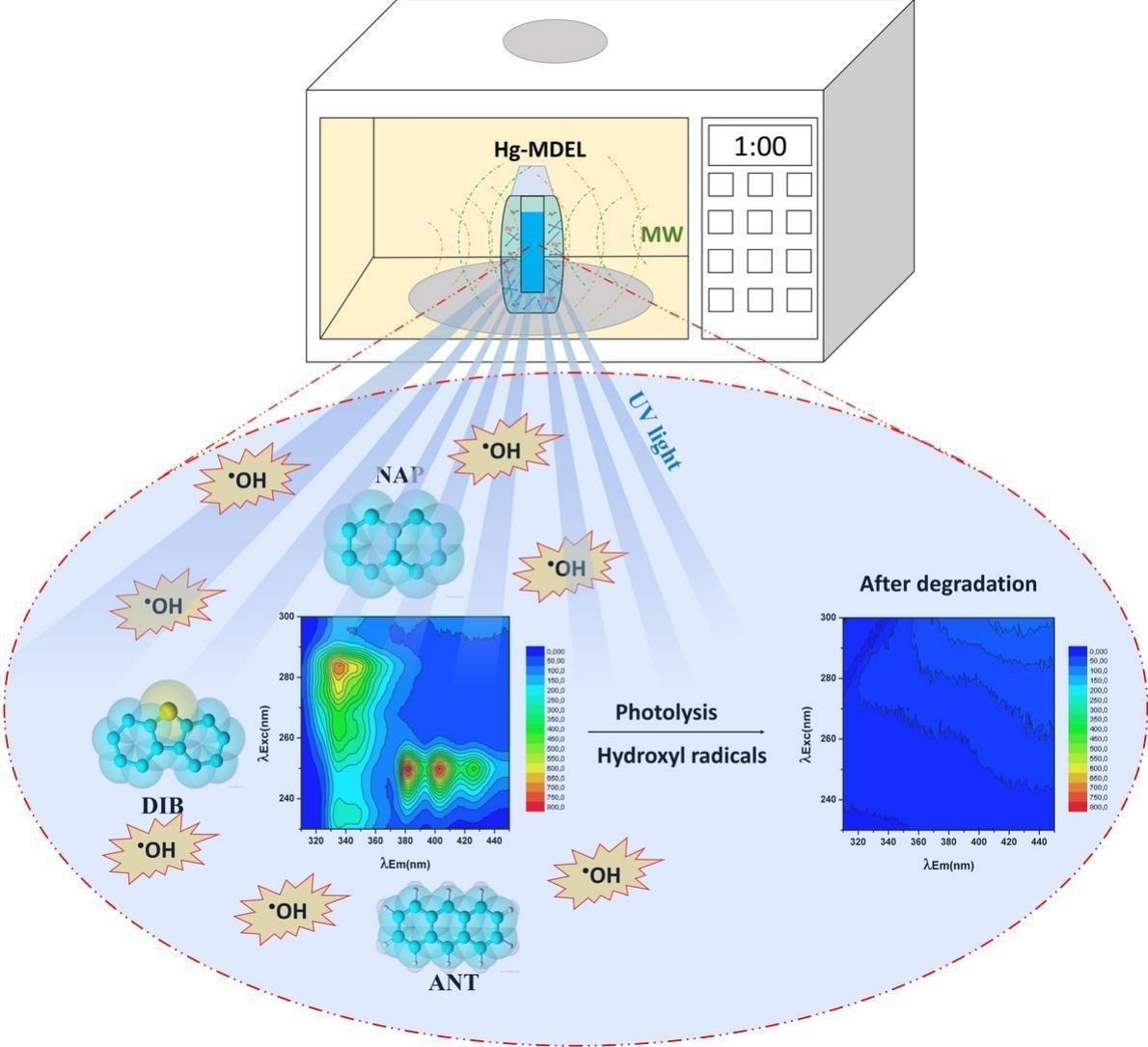The degradation and quantitative monitoring of a mixture of polycyclic aromatic hydrocarbons (PAHs), which are emerging pollutants that contaminate various ecosystems due to oil and other fossil fuel spills and improper disposal of industrial waste, are described in an article published in the journal Catalysis Communications. This approach is simple, effective, and sustainable.
 The mixture of pollutants was degraded by means of a photochemical system in which a light source is activated by microwave radiation. Image Credit: CDMF
The mixture of pollutants was degraded by means of a photochemical system in which a light source is activated by microwave radiation. Image Credit: CDMF
Chemical compounds that are not routinely monitored and cannot be eliminated by conventional wastewater treatment techniques but have lately been shown to be hazardous to human health and the environment are known as emerging contaminants. Examples include substances present in personal care products and medications, certain pesticides, and bisphenol, which is utilized in various plastic types.
Researchers from the Federal University of São Carlos (UFSCar), São Paulo State University (UNESP), and the Federal University of Paraíba (UFPB) in Brazil created a mixture that mimics the natural environment by containing low levels of naphthalene, anthracene, and dibenzothiophene in surface water to find solutions to this issue.
To identify and quantify each pollutant as well as other possible compounds present in natural water, they utilized excitation-emission matrix (EEM) fluorescence spectroscopy as a higher-order method of analysis and calibration in conjunction with parallel factor analysis for data processing.
With the help of this technology, each analysis could be finished in less than two minutes, and there was no need for more expensive or complex methods like chromatography.
Subsequently, the mixture underwent degradation by using a photochemical system, wherein microwave radiation activates a lamp. The device eliminated 88% to 100% of the organic contaminants in under one minute. This excellent performance was attributed to water photolysis, which produced hydroxyl radicals—oxidizing species that can break down organic contaminants quickly.
One of the study’s highlights, according to Kelvin C. Araújo, the first author and researcher at the Center for Development of Functional Materials (CDMF), a Research, Innovation and Dissemination Center (RIDC) funded by FAPESP and housed by UFSCar, was the choice of PAH monitoring technique. He clarified that the conventional approach, chromatography, hinders advancement in this type of study in many regions of the world due to the high cost of the necessary equipment and the more advanced training needed for the technique.
A spectrofluorometer, which is cheaper for many facilities, was employed by the researchers in this study. Compared to chromatography, the analysis can be completed up to five times more quickly, and no residue is left behind. Furthermore, Araújo pointed out that the group, which has long investigated water treatment utilizing chromatography as its primary analytical methodology, noticed a need for more approachable methodologies.
Photochemical System
Utilizing a microwave-activated photochemical method to break down the PAHs was a noteworthy addition to the study. One of the main challenges is efficiently and fast degrading new contaminants without using catalysts, according to Ailton Moreira, co-author of the study and researcher at UNESP Institute of Chemistry in Araraquara.
The challenge is even more daunting when you are working with mixtures of pollutants in natural water because of the many potential inhibitors of the degradation process, but the photochemical system performed outstandingly.
Ailton Moreira, Study Co-Author and Researcher, UNESP Institute of Chemistry
Moreira went on to say that similar systems have already shown promise in research pertaining to the degradation of pharmaceutical and agricultural waste. The photochemical system can be applied on a significantly bigger scale, such as in wastewater treatment facilities, according to the findings detailed in the study.
The authors affirm that future research will concentrate on the analytical technique as well as the degradation process in various projects headed by group members. The next step is to apply these technologies to monitor and degrade emerging contaminants at a wastewater treatment facility in the state of São Paulo, specifically in the city of Gavião Peixoto.
Journal Reference:
Araújo, K. C., et. al. (2024) Fast and efficient processes for oxidation and monitoring of polycyclic aromatic hydrocarbons in environmental matrices. Catalysis Communications. doi:10.1016/j.catcom.2023.106834